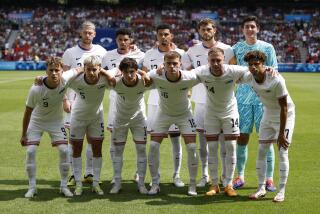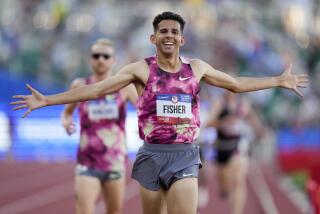A CHANCE THIS TIME : For Berryman, the Races With the Soviets Are Critical
When the United States matches wheels with the Soviet Union in a dual track cycling competition Oct. 2-4 at the Olympic Velodrome in Dominguez Hills, it will be the first time the two have ever met in head-to-head cycling competition, and, depending upon next yearâs international cycling calendar, it may be the last time they meet before the 1988 Summer Olympics in Seoul, South Korea.
For Scott Berryman, the superpower cycling competition is also a chance to change his streak of misfortune in international competitions. The 24-year-old from Boulder, Colo., has long been one of the top track cyclists in the United States and is currently the national match sprint champion.
But when it comes to taking on the world, the world often takes him on first.
He twice has missed qualifying for the national team for major international competitions. And when he made the team last year, he crashed.
In 1984, Berryman just missed qualifying for the U.S. Olympic team. This year he will be only an alternate at the Pan Am Games that start Saturday in Indianapolis, where Mark Gorski and Ken Carpenter are the competing team members. And at last yearâs world championships in Colorado Springs, Colo., he suffered a slight concussion and a torn rotator cuff muscle when he fell during a four-man repechage.
Yet for Berryman, the spills are a part of the game, and he says that his not making the 1984 Olympic or 1987 Pan Am Games squad--despite winning consecutive national match sprint titles--merely means that U.S. cycling is competitive.
â(The competition) just brings the level of U.S. cycling up that much more,â Berryman said. âIf I were really that dominant, I wouldnât get much better.â
The dual match against the Soviet Union, which sponsors hope will become an annual event, also should bring up the level of U.S. cycling, according to Berryman.
âThis event is important for a lot of people,â Berryman said as he made the rounds in Southern California trying to drum up support for the U.S.-Soviet competition. âItâs the first big track event in the United States since the Olympics, itâs the first time (for the United States) head-to-head against the Soviet Union, and everybody should be pretty much on form. Me, too, hopefully.â
The U.S.-U.S.S.R. Michelob Challenge is the third in a series of major competitions for U.S. cyclists this fall. The World Championships will be held in Vienna, Austria, and the pre-Olympic meet will follow in Seoul, both in September.
The dual meet against the Soviet Union is the brainchild of cyclists Gorski and Connie Paraskevin-Young, who convinced their agent, ProServ, to take advantage of its tennis connections with the Russian Sports Federation to set up a cycling competition. Among the expected riders on the U.S. team are Berryman, 1984 Olympic medalists Gorski, Nelson Vails and Rebecca Twigg-Whitehead, and world match spring champion Paraskevin-Young. Expected cyclists from the Soviet Union include former world champion Nicolais Kovche and current time-trial track record holder Viatcheslav Ekimovc.
While U.S. women, particularly Paraskevin-Young, have enjoyed a great deal of success in international cycling competitions that have included the traditional Eastern Bloc powers, the U.S. men are gaining grudging acceptance into the sportâs upper echelon.
âWeâre really an emerging power,â Berryman said. âIt used to be, when I first started, other teams would say, âThe Americans are here, so what.â Now the coaches donât leave the track when weâre practicing. They want to see what weâre doing.â
In addition to his bad luck, Berryman is also frequently the forgotten man in U.S. track cycling. He hasnât been as successful as Gorski, who stepped into the spotlight with his gold medal performance in the the Olympic match sprint event. Nor has he been as popular as Vails, the loquacious former bike messenger and silver medalist in the 1984 match sprints who delights both the press and the public with his tales of dodging cars and pedestrians on the crowded New York City streets.
Berrymanâs entry into competitive cycling was a bit more mundane than Vailsâ--he used to ride a tandem bicycle as a young boy with his mother in Springfield, Ohio. Since then, he has become one of the most powerfully built, strongest and fastest cyclists the United States has produced. At 5 foot 11 inchesand 183 pounds, Berryman looks as if he ought to be pushing wide receivers around secondaries instead of bicycles around tracks.
Berryman, however, hopes that his name, face and physique will become more familiar after the next 14 months.
â(The Olympics) have been a major focus ever since I was a kid,â Berryman said. âThe fact that cycling is an Olympic sport gives me an opportunity to reach my goal. Now I just have to take advantage of it.â
More to Read
Go beyond the scoreboard
Get the latest on L.A.'s teams in the daily Sports Report newsletter.
You may occasionally receive promotional content from the Los Angeles Times.






